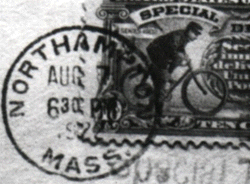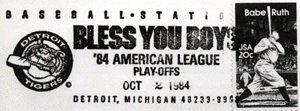
If you are a postal history collector, postmarks will be more important to you than the stamps themselves. Even for the collector of used stamps only, some postmarks are more desirable than others.
As an example, the 1847 10¢ Washington issue of the United States may bear a common red cancellation that makes the stamp's catalog price $2,000, while "Canada" or "Steamer 10" markings add another $1,000 to $1,250 to its value.
Hundreds of collectors save old and modern postmarks only, not really caring which stamp bears them. Postmarks thus spread over three philatelic fields: postal history, used stamps and postmark collections. Following is a description of general postmark terms that all collectors should understand:
Postmark is an all-inclusive term for any marking officially applied to a piece of mail as it passes through the mailstream. It not only includes the circle giving date and town data, but also all the extraneous markings indicating routing, directory service, postage due, censorship, registration, special delivery, forwarding, carriage by special transportation, and many others.
The lines canceling the stamp to prevent its reuse comprise a postmark. Any official marking on an envelope, such as "Mail delayed. Found in supposedly empty box, " is a postmark.
Datestamps are postmarks that show the date and sometimes the actual hour of mailing. The latter are from an earlier era; today's U.S. datestamps include only date, city and state information. When this date/town data is enclosed in a circle, the postmark is called a circular datestamp (CDS).

An example of a circular datestamp from 1922.
Cancellations are those portions of postmarks that mark the stamp to prevent its reuse. Prior to the advent of stamps to prepay postage, such markings only served to provide information to postal clerks as they handled the stampless envelope. After stamps came into use, cancellations became necessary to void the stamp for repeat usage.
Cancellations come in many forms: bars or wavy lines (called "killers"), ink blobs or fancy designs (called "obliterators"), and wording for special occasions (called "slogan cancels"). Even a postman's ball-point pen squiggle, placed on a stamp that escaped being canceled at the post office, is an official cancellation.

An example of a slogan cancel honoring the Detroit Tigers baseball team and their 1984 playoff appearance.
Canceled-to-order (CTO) stamps are mint issues with original gum that bear a cancellation, even though they have never been postally used. These cancels are most often applied to entire sheets of stamps as they are printed. Typically, they are small, quarter-circle marks found at the corners of stamps. Some postal administrations create these to sell them at a discount to the stamp trade. Such CTO stamps generally are not regarded as philatelically desirable.
Canceled-by-favor, or favor-canceled stamps are those canceled in a specific manner at the request of a collector. Anytime a collector asks for and receives a form of cancellation that otherwise would not have been applied to the material being mailed, it can be described as "canceled-by-favor. " Such an item may or may not pass through the mailstream.
Obtaining current postmarks is an activity of many postmark collectors. Requests should be addressed to the postmaster of the post office from which the postmark is desired. State the type of marking wanted: either the office's regular machine cancel, with or without slogan; or the standard handstamp, with or without killer bars.
At times, special pictorial handstamps are used for a short period. These are announced in advance in releases from the U.S. Postal Service, and often in the philatelic press such as Linn's Stamp News.
To obtain the marking desired, prepare a cover by placing first-class postage in the upper right corner, approximately one-fourth inch from the edges of the envelope. Postal cards also are acceptable. Since postal regulations state that unaddressed covers may not be canceled and returned under separate cover, you must address the cover to yourself in the lower right-hand portion of the envelope or card.
Many collectors prefer to use peelable labels for this purpose. Placing a stuffer of postcard thickness in the envelope usually will ensure a cleaner, sharper postmark. Insert the prepared cover and your note of cancel request in an outer envelope stamped with first-class postage, and send it to the proper postmaster.